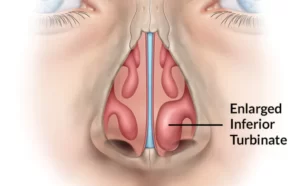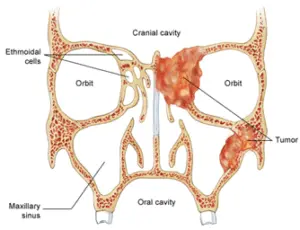Sinus Conditions
Nasal complaints are among the most common conditions for which patients seek medical care, including nasal congestion, runny nose, post nasal drip, and nose bleeds. As a sinus doctor and sinus specialists in Singapore, we will ensure an accurate diagnosis and a comprehensive treatment plan to solve all your nose and sinus issues.
What Is The Function Of The Nose And Sinuses?
The nose serves as the entrance to the respiratory tract and contains the organ of smell. It provides air for breathing, helps us smell, conditions the air by filtering, warming, and moistening it, and cleans itself of foreign debris extracted from the air.
The nose is divided into the right and left sides by the nasal septum. The septum is made of bone and cartilage and covered by a thin layer of skin (mucosa).
There are 4 pairs of paranasal sinuses: The maxillary sinus in the cheek, ethmoid sinus between the eyes, frontal sinus in the forehead and the sphenoid sinus towards the middle of the skull. These sinus cavities are normally air-filled and are lined with skin that produces mucous. Normally, mucous is easily swept out of the sinus cavity into the nasal cavity where it ultimately passes into the throat and is swallowed. However, if the sinus becomes blocked due to inflammation from allergies, infection or nasal polyps, mucous can accumulate and air cannot enter into the sinuses. This results in sinus pain, facial pressure and if prolonged, can lead to a sinus infection, termed ‘sinusitis’.
What Is Epistaxis?

Epistaxis is more commonly known as nosebleeds. They can be further classified into anterior and posterior. Anterior is where the bleeding comes out from the front of the nose, and posterior is where bleeding flows down the back of the throat and is either coughed or spat out.
By and large, epistaxis is a common condition that can be treated with conservative measures. However, epistaxis may also indicate more serious underlying conditions such as nasal infections and nasal tumours.
Within the local Singaporean adult population, nasopharyngeal cancer may present as epistaxis.
What Are The Causes Of Epistaxis (Nosebleeds)?
There are various factors that lead to epistaxis. These include:
- Trauma
- Allergies
- Foreign bodies in the nose
- Low humidity / dryness
- Certain medications
- Certain conditions that predispose to bleeding
- Nasal infections / Sinusitis
- Nasal tumours
How Do I Manage Epistaxis (Nosebleeds) At Home?
If you are suffering from a nosebleed, you can attempt to stop the bleeding by pinching the nostrils firmly for 5-10 minutes. Additionally, you may gargle iced water, suck on ice cubes, or hold an ice pack to the forehead.
When Should I See a Doctor For Epistaxis (Nosebleeds)?
You should see a doctor for a nosebleed if it fails to stop after 10 to 15 minutes of conservative measures, such as those mentioned above.
Additionally, you should see a doctor for nosebleeds if they are recurrent, or if there is a history of smoking or a family history of nasopharyngeal cancer.
What Are the Treatment Options For Epistaxis (Nosebleeds)?
When treating and managing nosebleeds, our doctors will treat the underlying conditions, if any. Allergies may be controlled with medication, and environmental modifications may be required. For example, patients may need to humidify their air or decrease prolonged exposure to dry air.
In persistent cases of epistaxis, patients can be treated under local anaesthetic with either chemical cautery or with a device using a small electrical current to generate heat to seal off blood vessels.
In severe cases, surgery may be required to tie off blood vessels in the nose to reduce the chance of bleeding.
Can Epistaxis (Nosebleeds) Be Prevented?
Epistaxis can be prevented by treating any underlying conditions and controlling allergies with medication. Additionally, environmental factors such as dry air Identified and corrected if possible.
What Is Rhinitis?
Rhinitis is defined as inflammation of the lining of the nose. Symptoms of rhinitis include:
- Runny nose with clear discharge
- Blocked nose
- Nasal itch
- Red / itchy eyes
- Coughing
- Post-nasal drip
What Are The Different Types Of Rhinitis?
Rhinitis can be broadly classified into allergic and non-allergic rhinitis. The predominant form of rhinitis is allergic rhinitis.
What Is Allergic Rhinitis?
 Allergic rhinitis, known colloquially as ‘sinus’ locally, is inflammation that occurs in your nose when your immune system reacts to particles in the air which you breathe in. These come into contact with the lining of the nose and incite allergic responses such as a runny nose and sneezing.
Allergic rhinitis, known colloquially as ‘sinus’ locally, is inflammation that occurs in your nose when your immune system reacts to particles in the air which you breathe in. These come into contact with the lining of the nose and incite allergic responses such as a runny nose and sneezing.
What Are The Treatment Options For Allergic Rhinitis?
The cornerstone of management of allergic rhinitis is to determine the allergen / allergens in question. The main methods of treatment, which can be used individually or concurrently are as follows:
Allergen Avoidance
After an allergen is identified, environmental interventions can be undertaken to reduce exposure to the allergen. For example, if a house dust mite allergy is identified, precautions such as anti-dust mite bed covers and pillowcases can be used to reduce allergen exposure.
Medications
Intranasal corticosteroids and antihistamines are effective in treating symptoms of allergic rhinitis.
Immunotherapy
In certain cases where the individual is sensitive, for example, to house dust mites, immunotherapy for desensitization can be an effective and long-lasting treatment option.
Surgery
In certain cases where medical treatment has failed, there are surgical options such as cryotherapy (cold treatment) to the posterior nasal nerve to reduce the incidence of runny nose. In patients with allergic rhinitis who have nasal blockage predominantly, inferior turbinate reduction or septoplasty can be performed.
What Is A Sinus Infection (Sinusitis)?
 Sinusitis or a sinus infection is defined as inflammation of these mucus-producing membranes that line your sinuses. It is common to experience a sinus infection after a cold or if you suffer from allergy flare-ups.
Sinusitis or a sinus infection is defined as inflammation of these mucus-producing membranes that line your sinuses. It is common to experience a sinus infection after a cold or if you suffer from allergy flare-ups.
What Are Some Symptoms Of Sinus Infections?
Some common symptoms of a sinus infection include:
- Nasal discharge, which may be green or yellow
- Blocked nose / nasal congestion / sinus congestion
- Foul odours in the nose
- A decrease in one’s ability to smell
- Pressure over the forehead or cheeks
- Facial pain
- Persistent cough
- Fever
- Fatigue
- Bad breath
- Dizziness
What Are The Different Types Of Sinus Infections (Sinusitis)?
Sinusitis can be classified as either acute or chronic. The main difference is how long a patient suffers from the condition. Acute sinusitis typically lasts less than 3 months, while chronic sinusitis lasts over 3 months.
What Are Some Of The Causes Of Sinus Infections (Sinusitis)?
There are various causes that can lead to sinusitis. Common causes of sinus infection include bacterial, viral, or fungal causes, a weakened immune system, and structural abnormalities in the nose.
How Are Sinus Infections Diagnosed?
In order to diagnose sinusitis, our doctors may recommend an endoscopic examination. Additionally, our doctors may ask questions regarding your medical history to better understand your condition.
In some cases, imaging scans may be required to aid our doctors in diagnosing sinus infection in a patient.
What Are Some Treatments For Sinus Infections (Sinusitis)?
We understand that sinusitis can be extremely frustrating. After properly diagnosing your condition, we may initially recommend various non-surgical treatment methods, these include:
- Antibiotics for bacterial sinusitis
- Intranasal steroids
- Intranasal antihistamines / decongestants
- Oral antihistamines / decongestants
In more severe cases of sinus infection, or when non-surgical treatment methods have proven unsuccessful, our doctors may recommend:
- Sinus surgery
- Long-term intranasal steroids
- Biologic treatments for patients with nasal polyps
What Causes Sinus Infections (Sinusitis)?
As mentioned, patients prone to allergies may be more likely to develop sinusitis. Patients with allergies can aim to achieve better control over their allergic reactions by avoiding known allergens to reduce their chances of developing sinusitis.
Alternatively, patients with structural abnormalities of the nose may be predisposed to developing sinusitis. Speak to our doctors about correcting these abnormalities to reduce the incidence of sinusitis.
What Is A Deviated Nasal Septum?
 The nasal septum is a partition in your nose made from cartilage and bone. It separates the internal nasal cavity into the right and left sides. A deviated nasal septum is used to describe a condition where this partition is crooked, subsequently narrowing one side of the nasal cavity.
The nasal septum is a partition in your nose made from cartilage and bone. It separates the internal nasal cavity into the right and left sides. A deviated nasal septum is used to describe a condition where this partition is crooked, subsequently narrowing one side of the nasal cavity.
What Are The Symptoms Of A Deviated Nasal Septum?
A deviated septum is most commonly results in a blocked nose, usually predominantly on one side. You can perform a quick test at home by covering one nostril with your finger and breathing. Repeat this step for the other nostril. You may have a deviated septum if you find it easier to breathe on one side than the other.
However, you should always consult a doctor for a more accurate diagnosis.
Is A Deviated Nasal Septum Cause For Concern?
A deviated septum can cause nasal obstruction. Additionally, it may potentially predispose one to recurrent or chronic nasal infections.
What Are Some Causes Of A Deviated Nasal Septum?
There are several factors that may lead to a deviated septum. These include:
- Congenital (born)
- Developmental
- Previous trauma to the nose
What Are The Risks And Complications Of A Deviated Nasal Septum?
As mentioned, a deviated septum can cause nasal obstruction and put patients at risk for recurrent or chronic nasal infections.
When Should I See A Doctor For A Deviated Nasal Septum?
If you suffer from persistent nasal obstruction or recurrent or chronic nasal infections as a result of a deviated septum, seek medical advice from a doctor. Our doctors will be able to help treat and manage your condition.
What Are The Treatment Options For A Deviated Nasal Septum?
Treatment options for a deviated septum primarily consist of surgery (septoplasty) that attempts to relieve the anatomical obstruction.
Can a Deviated Septum Be Prevented?
Unfortunately, congenital and developmental forms of a deviated septum cannot be prevented. However, one can prevent a deviated septum that occurs as a result of trauma to the nose with early intervention
What is Inferior Turbinate Hypertrophy?
 The inferior turbinates are bony structures in the nose which are covered with a nasal lining (mucosa). This nasal lining contains numerous blood vessels, which can fill with blood causing the mucosa to swell.
The inferior turbinates are bony structures in the nose which are covered with a nasal lining (mucosa). This nasal lining contains numerous blood vessels, which can fill with blood causing the mucosa to swell.
Swelling of this mucosa decreases the space in the nasal cavity and leads to nasal blockage and obstruction.
Inferior turbinate hypertrophy is commonly found in patients with concurrent allergic rhinitis. They can also easily be mistaken for nasal polys on a routine examination, and are best evaluated with a nasoendoscopic examination.
Is Inferior Turbinate Hypertrophy Cause For Concern?
Inferior turbinate hypertrophy can cause nasal blockage and obstruction. Some patients with inferior turbinate hypertrophy also have a deviated nasal septum, which further worsens the nasal obstruction.
What Are The Treatment Options For Inferior Turbinate Hypertrophy?
Inferior turbinate hypertrophy can be treated with medications such as intranasal steroids, antihistamines and decongestants. However, these medications must be used regularly to prevent the issue from recurring. A longer term solution would consist of surgical procedures such as radiofrequency ablation of the inferior turbinates, or inferior turbinoplasty / turbinectomy.
Can Inferior Turbinate Hypertrophy Be Prevented?
Inferior turbinate hypertrophy occurs commonly in patients with allergic rhinitis. Treatment of this underlying condition, either through medical or surgical means, can help control inferior turbinate hypertrophy.
What Are Some Uncommon Nasal And Sinus Conditions?
Nasal And Sinus Tumors
 Sinus and nasal cavity tumors are most commonly benign (non-cancerous) and typically do not spread to other parts of the body. Malignant (cancerous) tumors are uncommon. Squamous cell carcinoma is the most common type of cancer found in the sinuses and nasal cavity. Other types of cancer include: adenocarcinoma, salivary gland cancers, lymphoma, melanoma and esthesioneuroblastoma (olfactory neuroblastoma). Some of these malignant tumors may invade areas adjacent to the sinuses and nasal cavity, such as the brain, eye and oral cavity.
Sinus and nasal cavity tumors are most commonly benign (non-cancerous) and typically do not spread to other parts of the body. Malignant (cancerous) tumors are uncommon. Squamous cell carcinoma is the most common type of cancer found in the sinuses and nasal cavity. Other types of cancer include: adenocarcinoma, salivary gland cancers, lymphoma, melanoma and esthesioneuroblastoma (olfactory neuroblastoma). Some of these malignant tumors may invade areas adjacent to the sinuses and nasal cavity, such as the brain, eye and oral cavity.
The diagnosis for a sinus tumor relies on a thorough history/physical examination, imaging studies and ultimately a biopsy of the mass. The biopsy is reviewed with a pathologist to determine the proper diagnosis.
Treatment of sinus tumors is coordinated with a variety of other physicians including ophthalmologists, neurosurgeons, medical and radiation oncologists when indicated. Treatment may include extensive sinus surgery with complex reconstructions, radiation and/or chemotherapy.
Cerebrospinal Fluid Leaks
Cerebrospinal fluid (CSF) is fluid that provides nourishment and protection to the brain and spinal cord. It surrounds the brain and also helps cushion the it from potential injury. CSF leaks occurs when this fluid leaks through a hole in the dura (the covering of the brain) and the bone of the skull. The fluid commonly drains from the nose depending on where this defect is located. The leak can be the result of trauma, prior surgery or can at times occur spontaneously without any identifiable cause.
Patients with CSF leaks typically complain of clear, watery drainage usually only from one side of the nose. The drainage can worsen with tilting the head forward and/or straining. Other symptoms can include headaches, visual changes, and recurrent infections of the lining of the spinal cord (meningitis).
If drainage can be collected it will be sent for laboratory testing to confirm that it is CSF. Imaging studies such as CT scans or MRI may be ordered for evaluation and assess the potential points of leakage.
Treatment can be either medical or surgical. Conservative treatment is usually recommended first in cases of spontaneous CSF leak or after head trauma. Surgical treatment of CSF leaks is used when conservative measures fail. Surgery can usually be performed using an endoscopic approach through the nostril often in conjunction with a neurosurgeon.
Frequently asked questions
Sinus conditions We treat
- Acute Sinusitis
- Sinus Infections
- Sinus Pressure and Pain
- Chronic Sinusitis and Polyps
- Nasal Polyps
- Nasal Congestion
- Postnasal Drip
- Taste and Smell Disorders
- Deviated Nasal Septum
- Broken Nose








